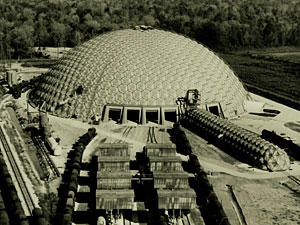How could a building that combined the genius of Buckminister Fuller and the power of the Union Tank Car Company become obsolete in little more than ten years? That is the question posed by filmmaker Evan Mather in his recently released, 30-minute documentary, A Necessary Ruin: The Story of Buckminister Fuller and the Union Tank Car Dome.

Photo © Ivan Massar
The steel, geodesic dome was completed in 1958 in a field north of Baton Rouge, Louisiana. With a diameter of 384 feet, it was the largest free-span structure in the world at the time and was considered a marvel among engineers and architects. But to its owner, Chicago-based Union Tank Car Company, which manufactured, leased, and maintained railroad tank cars used to transport petroleum, the dome’s value was more prosaic: It was a weather-proof structure that allowed Union Tank to repair dozens of tank cars at a time rather than one or two.
Its value was short-lived, however. When the standard size of tank cars went from 50 to 60 feet in length in the late 1960s, the cars became too long for the specially designed roundhouse. Rather than retrofit the building, Union Tank moved out, and the building sat vacant. The dome and rail yard were sold to Kansas City Southern Railway in 1990. In 2007, one year before it was eligible for National Register of Historic Places designation, the dome was razed.
“This was supposed to be a world famous piece of architecture, and here it was a genuine ruin rusting away in the wilderness,” said 40-year-old Mather, a filmmaker and landscape architect with Los Angeles-based AHBE. Among his best-known short films are So What?, Image of the City, and Scenic Highway, a quirky travelogue about Baton Rouge, his hometown.
In A Necessary Ruin, Mather tells the story of an exuberant collaboration between Richard Lehr, the Union Tank Car Company’s clever and innovative chief engineer, and Fuller, who brought his expertise to the enterprise. Through vivid animations, blueprints and oral history interviews with some of people who worked on the dome, along with hundreds of photographs taken during the dome’s conception, construction, and decline, Mather conveys the pride of the men who built it and the passion of those who tried to save it. The film features an interview with Lehr, who, at the age of 82, died three months before the dome came down.
Mather’s film sounds a cautionary note about imperiled modern-era structures and the often prohibitive costs of maintaining them. A Necessary Ruin had its premiere on March 22 at the National Building Museum in Washington, D.C., and will be shown this Friday, April 30, at AIA New York’s Center for Architecture. The viewing is part of the center’s Modernism at Risk exhibition.




Post a comment to this article
Report Abusive Comment